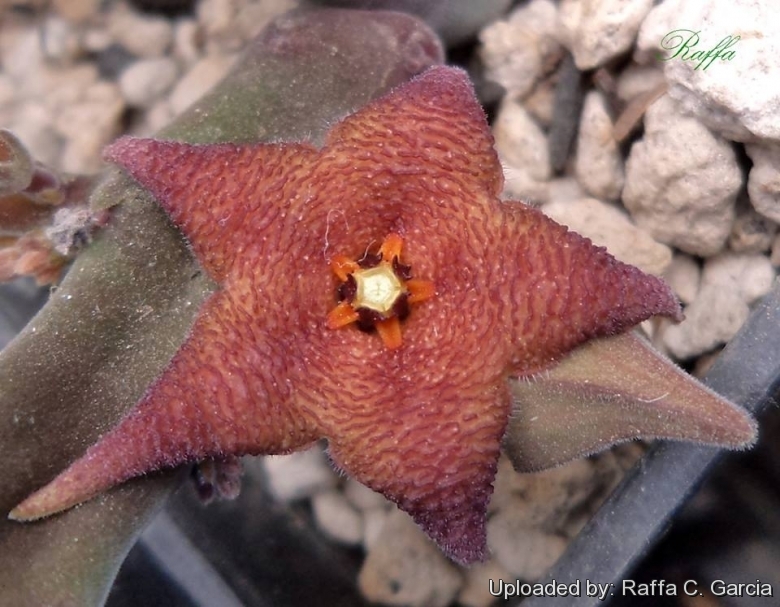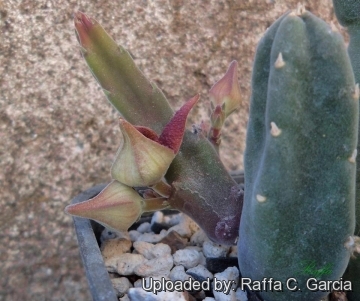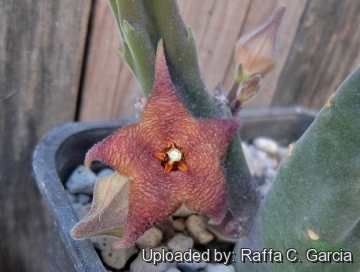Accepted Scientific Name: Stapelia rufa Masson
Stapel. Nov. 16. t. 20. 1797 [Mar 1797] Masson

Gonostemon rufus (Stapelia rufa) Photo by: Raffa C. Garcia
Origin and Habitat: Stapelia rufaSN|30285]]SN|30285]] is a South African endemic, Provincial distribution Northern Cape, Western Cape. The centre of distribution lies in the Little Karoo, as well as very scattered localities along the escarpment from near Loeriesfontein to Fraserburg in the Great Karoo.
Habitat and ecology: It usually grows on stony, north-facing slopes, and like many stapeliads, in the protection of bushes.
Synonyms:
See all synonyms of Stapelia rufa
back
Accepted name in llifle Database:Stapelia rufa MassonStapel. Nov. 16. t. 20. 1797 [Mar 1797]Synonymy: 7
back
Common Names include:
ENGLISH: carrion flower
AFRIKAANS (Afrikaans): aasblom
Description: Stapelia rufaSN|30285]]SN|30285]] is a tufted cactus-like plant to 100-220 mm tall, with small-sized and showy dull, dark purple, dark red or yellow star-fish shaped flowers. The flowers appear at random on the stem, but mainly at the base of the four cornered velvety branches, the peduncles are shorter than the corolla which is transversely wrinkled, with a shallow depression at the centre and pointed lobes, minutely ciliate at the edge, glabrous at the base, but with pubescent tips, a very unusual combination. Corona raised, outer lobes subquadrate, orange; inner lobes erect, oblong black. This species flowers in spring.
Derivation of specific name: As the name implies, this is the 'rusty-red stapelia'.
Stems: Erect, not decumbent at the base, 10-18 cm high, 12-18 mm square, with shallow grooves between the obtuse, toothed angles and nearly flat sides when mature, softly and minutely puberulous, at first green, becoming olive-green or tinted with dull purple with age.
Leaves: Erect rudimentary 1.5-2 mm long at the tip of the teeth.
Flowers: The inflorescence develops producing clusters of 3–5 campanulate dull, dark red to yellow flowers that appears at the base or near the middle of the young stems, successively developed. Pedicels 3-8 mm long, stout, velvety. Sepals 4-5 mm long, tapering from the base to an acute apex, velvety; corolla in bud ovate, acuminate, when expanded 3-4 cm in diameter, velvety puberulous on the back, inner surface closely transversely rugose all over, with the shallowly and broadly funnel-like depressed disk. The lobes narrowing, almost tailed, and base glabrous, their terminal part being pubescent or puberulous and minutely ciliate with purple hairs all along or sometimes with hairs 1-2 mm long, at the basal part, entirely dull dark red or chocolate-red, or with slender dull olive-green lines between the transverse ridges on the disk and basal half of the lobes, which are 14-16 mm long, 7-8 mm broad, attenuate-acuminate from about the middle to the rather slender tips from an ovate base, very spreading or recurving, with recurved margins. Outer corona-lobes spreading, 1-1.5 mm long, 1-1.5 mm broad, subquadrate or transversely subrectangular, subtruncate, obscurely crenulate or with a very short obtuse-angled point at the apex, channelled down the face, very dark orange or reddish-orange (in dried flowers apparently yellow-ochre), microscopically ciliate; inner corona-lobes erect, 1.5 mm long, narrowly oblong or subcuneate-oblong, viewed from the back, subtruncate or obtuse to shortly bifid at the apex, with a short compressed projection or gibbosity at the base on the back, minutely puberulous, nearly black, shining; anthers yellow.
Bibliography: Major references and further factures
1) N. E. Brown “Flora Capensis”, Vol 4, page 518, (1909)
2) Foden, W. & Potter, L. 2005. Stapelia rufa Masson. National Assessment: Red List of South African Plants version 2015.1. Accessed on 2016/06/15
3) “Encyclopaedia Londinensis, or, Universal dictionary of arts, sciences, and literature”, Volume 23. 1828
4) Alain Campbell White, Boyd L. Sloane “The Stapelieae”, Volume 2 Typography and printing by S. E. Haselton at Abbey San Encino Press, 1937
5) Doreen Court “Succulent Flora of Southern Africa” CRC Press, 01 June 2000
 Gonostemon rufus (Stapelia rufa) Photo by: Raffa C. Garcia
Gonostemon rufus (Stapelia rufa) Photo by: Raffa C. Garcia Gonostemon rufus (Stapelia rufa) Photo by: Raffa C. Garcia
Gonostemon rufus (Stapelia rufa) Photo by: Raffa C. GarciaCultivation and Propagation: Stapelia rufaSN|30285]]SN|30285]] is one of many species suitable for a small pot. In cultivation it is one of the easier stapelias to grow.
Water requirements: It needs regular watering, especially abundant during the hottest summer day, waterings will begin at the first signs of vegetation and could be stopped in autumn, either excessive and very scarce watering can induce rot.
Hardiness: It resists temperatures approaching of 0° C (under good conditions), but it is more cautious to provide it a minimum of 8 to 10°C.
Light requirements: It take a great advantaged if grown in very strong light but does not have to be in full sun during the hottest hours. Keep the plant in a ventilated and dry environments.
Soil: The potting mix must be drained but nutrient.
Pest and diseases: The main problems is to avoid the “black spots” disease and other rots which can in a very short time destroy the plants. If rots starts the plant will almost inevitably die.
Propagation: Like most stapeliads, plants become senescent after several years, so they should be restarted from cuttings when growth and flowering slow. The multiplication is easy: Take away a fresh stem, let dry the cut surface, then put it out of ground, simply posed on the substrate in semi-shade. The best time is in late summer when they’re growing most actively. The one problem is that if the stem is even partially buried, the plant will usually rot. Cuttings should simply be laid on the surface of the potting medium. Healthy young plants grow rampantly.












